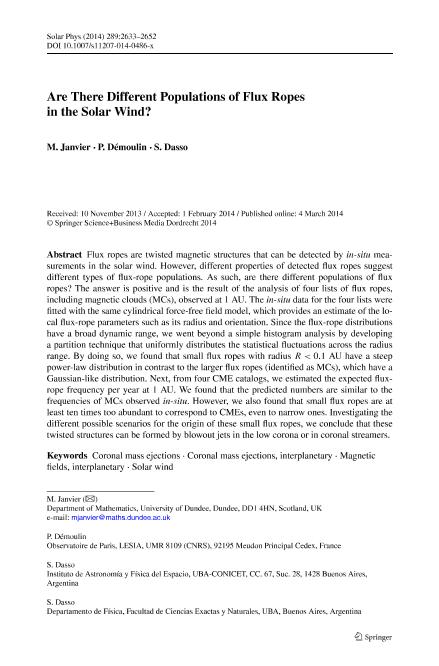Mostrar el registro sencillo del ítem
dc.contributor.author
Janvier, M.
dc.contributor.author
Démoulin, Pascal

dc.contributor.author
Dasso, Sergio Ricardo

dc.date.available
2017-05-12T22:37:40Z
dc.date.issued
2014-07
dc.identifier.citation
Janvier, M.; Démoulin, Pascal; Dasso, Sergio Ricardo; Are There Different Populations of Flux Ropes in the Solar Wind?; Springer; Solar Physics; 289; 7; 7-2014; 2633-2652
dc.identifier.issn
0038-0938
dc.identifier.uri
http://hdl.handle.net/11336/16457
dc.description.abstract
Flux ropes are twisted magnetic structures that can be detected by in-situ measurements in the solar wind. However, different properties of detected flux ropes suggest different types of flux-rope populations. As such, are there different populations of flux ropes? The answer is positive and is the result of the analysis of four lists of flux ropes, including magnetic clouds (MCs), observed at 1 AU. The in-situ data for the four lists were fitted with the same cylindrical force-free field model, which provides an estimate of the local flux-rope parameters such as its radius and orientation. Since the flux-rope distributions have a broad dynamic range, we went beyond a simple histogram analysis by developing a partition technique that uniformly distributes the statistical fluctuations across the radius range. By doing so, we found that small flux ropes with radius R<0.1 AU have a steep power-law distribution in contrast to the larger flux ropes (identified as MCs), which have a Gaussian-like distribution. Next, from four CME catalogs, we estimated the expected flux-rope frequency per year at 1 AU. We found that the predicted numbers are similar to the frequencies of MCs observed in-situ. However, we also found that small flux ropes are at least ten times too abundant to correspond to CMEs, even to narrow ones. Investigating the different possible scenarios for the origin of these small flux ropes, we conclude that these twisted structures can be formed by blowout jets in the low corona or in coronal streamers.
dc.format
application/pdf
dc.language.iso
eng
dc.publisher
Springer

dc.rights
info:eu-repo/semantics/openAccess
dc.rights.uri
https://creativecommons.org/licenses/by-nc-sa/2.5/ar/
dc.subject
Coronal Mass Ejections
dc.subject
Coronal Mass Ejections, Interplanetary
dc.subject
Magnetic Fields, Interplanetary
dc.subject
Solar Wind
dc.subject.classification
Astronomía

dc.subject.classification
Ciencias Físicas

dc.subject.classification
CIENCIAS NATURALES Y EXACTAS

dc.title
Are There Different Populations of Flux Ropes in the Solar Wind?
dc.type
info:eu-repo/semantics/article
dc.type
info:ar-repo/semantics/artículo
dc.type
info:eu-repo/semantics/publishedVersion
dc.date.updated
2017-05-02T20:13:29Z
dc.identifier.eissn
1573-093X
dc.journal.volume
289
dc.journal.number
7
dc.journal.pagination
2633-2652
dc.journal.pais
Países Bajos

dc.journal.ciudad
Dordrecht
dc.description.fil
Fil: Janvier, M.. University of Dundee; Reino Unido
dc.description.fil
Fil: Démoulin, Pascal. Centre National de la Recherche Scientifique; Francia
dc.description.fil
Fil: Dasso, Sergio Ricardo. Consejo Nacional de Investigaciónes Científicas y Técnicas. Oficina de Coordinación Administrativa Ciudad Universitaria. Instituto de Astronomía y Física del Espacio. - Universidad de Buenos Aires. Facultad de Ciencias Exactas y Naturales. Instituto de Astronomía y Física del Espacio; Argentina. Universidad de Buenos Aires. Facultad de Ciencias Exactas y Naturales. Departamento de Física; Argentina
dc.journal.title
Solar Physics

dc.relation.alternativeid
info:eu-repo/semantics/altIdentifier/doi/http://dx.doi.org/10.1007/s11207-014-0486-x
dc.relation.alternativeid
info:eu-repo/semantics/altIdentifier/url/https://link.springer.com/article/10.1007%2Fs11207-014-0486-x
Archivos asociados
